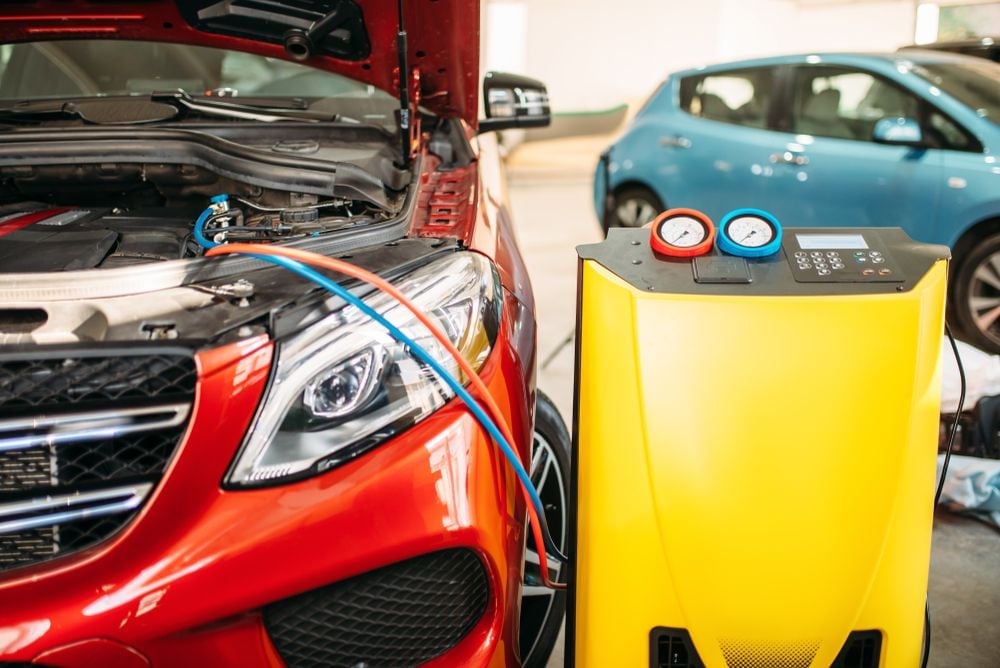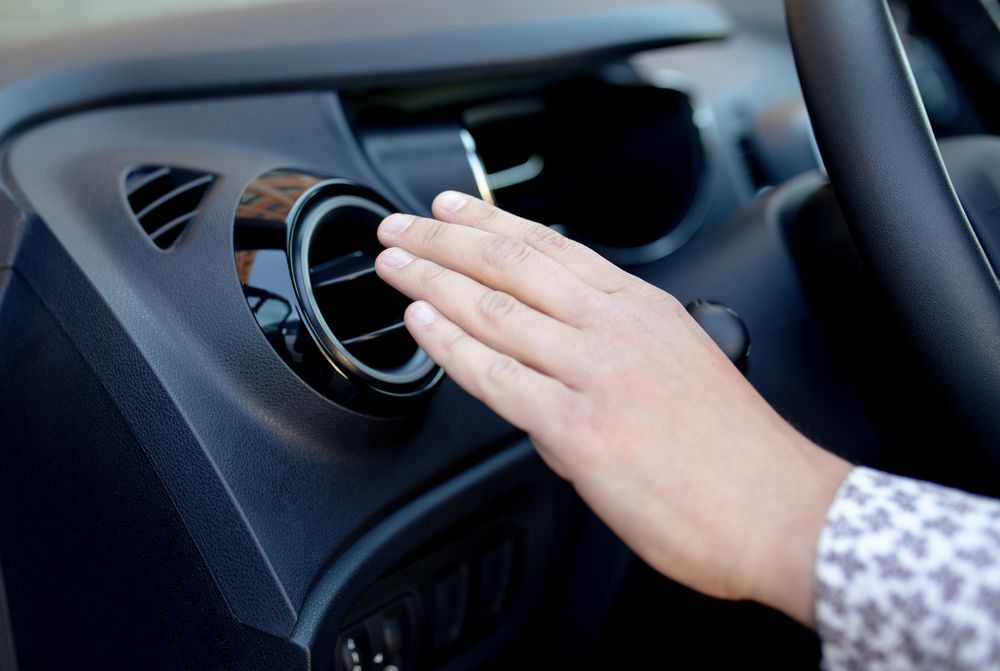
If your AC is blowing room temperature air, it's time for a recharge. Thankfully, it doesn't take as long as you think.
A complete recharge — emptying the system and replacing the gas — takes just 40 to 50 minutes when done by a professional.
However, DIY AC recharges can be as quick as ten to 15.
Below we'll go over the tell-tale signs, the step-by-step process, and the costs of vehicle AC recharges.
 Car getting its AC recharged at the auto repair shop
Car getting its AC recharged at the auto repair shop
How Long Does It Take to Recharge Car AC?
It takes between 40 and 50 minutes to recharge your car's AC by entirely replacing the old gas with fresh refrigerant.
You can decrease the duration to around ten or 15 minutes with a few tricks, but it's always better to take your time.
Why Does Your Car AC Run Out of Refrigerant?
Car AC systems don't consume refrigerant during daily operations, although small amounts do evaporate because an AC system can not be completely sealed.
Occasionally, refrigerant is lost due to extreme temperatures and vibrations that cause excessive wear on the hoses and connections, resulting in a refrigerant loss.
Other causes of gas loss are as follows:
How Do I Know If My Car Air Conditioner Needs Recharging?
Unless you're an experienced mechanic, it's tricky to know whether your car's air conditioner needs recharging. The most obvious symptom is when you're low on Freon.
How Do You Know If Your Car AC Is Low on Freon?
When you're low on Freon, your car's AC system will show these four tell-tale signs:
The AC Is Blowing Warm Air
The most apparent symptom is your AC is blowing room temperature or warm air from the vents.
Naturally, a functioning AC system should blow cool air.
If the air output is warm, you are likely low on Freon.
 AC blowing warm air
AC blowing warm air
The Clutch Does Not Engage
You should hear the clutch engage when you turn your car's AC on. This is because it allows the compressor to pressurize the refrigerant.
The clutch reads Freon levels to operate. Without enough refrigerant, it can't function.
You typically need an AC recharge if you don't hear it activate.
There Is Visible Air Leakage
In its liquid state, Freon appears thin and greasy.
It's common to find it around the compressor, lines, or inside the cabin.
If you spot liquid that could be Freon, clean it before checking the area later. If it has reappeared, your AC is suffering from a Freon leak.
The Compressor Is Icy
Ice on the compressor may indicate low Freon levels. Moisture takes the refrigerant's place, turning icy.
DIY AC Recharge VS Professional
You can do an AC recharge yourself or take it to a professional.
Your preferred method should depend on your DIY skills, confidence, and budget.
How Easy Is It To Recharge Car AC?
Recharging your vehicle's AC yourself is a temporary solution. After all, refrigerant doesn't leak from an airtight system, so it needs fixing by a professional.
Despite that, you can recharge it at home in seven relatively easy steps:
First, turn on AC — Make sure it's on Max or High.
Is the AC compressor on? — The clutch should spin with the accessory belt when the AC is on high.
Test pressure — Turn the vehicle off and locate the low-side pressure port. It's marked with a black or gray cap with the letter "L."
Attach recharge hose — Using an AC recharge kit, attach the quick-connect fitting over the port and firmly press down. It clicks into place.
Restart vehicle and monitor gauge — Once the compressor engages and the low-side pressure is sub 40 psi; your system requires charging.
Thread refrigerant container — Thread the Freon container onto the hose and hold it upright. Squeeze trigger for five to ten seconds to add refrigerant. Release the trigger and check the pressure gauge. It should be as close to 40 psi as possible. Repeat if necessary.
Check the temperature — Insert a meat thermometer into one of the driver's side AC vents inside the vehicle. Fully charged systems blow air as cold as 28 degrees, but it varies depending on ambient temperature.
How Much Should It Cost To Recharge A Car AC?
The prices given below are based on national averages for all vehicles. Remember that it doesn't include taxes, fees, or specific makes and models.
The cost fluctuates drastically depending on whether you perform a DIY recharge or hire a professional mechanic.
DIY Recharge Cost: $20 to $50
Since a Do-It-Yourself recharge kit is so inexpensive, it's worth recharging yourself initially, provided you're somewhat confident with basic DIY.
Professional Recharge Cost: $123 to $155
If there's a significant leak in your AC system, you have no choice but to take it to a qualified mechanic.
While it's more expensive, you're guaranteed an end to your AC woes. The specialized equipment quickly determines the leak's source and repairs it easily.
How Long Does An AC Recharge Last?
Your AC isn't constantly running. So, unless you live in a sweltering climate, you should expect a recharge to last at least three years.
Some car owners plan a recharge every three years to ensure nothing goes wrong with their air conditioning system.
Conclusion
Professional mechanics can recharge your AC for lasting results in just 40 to 50 minutes.
You'll never need to search "how long does it take to recharge car air conditioning" again!